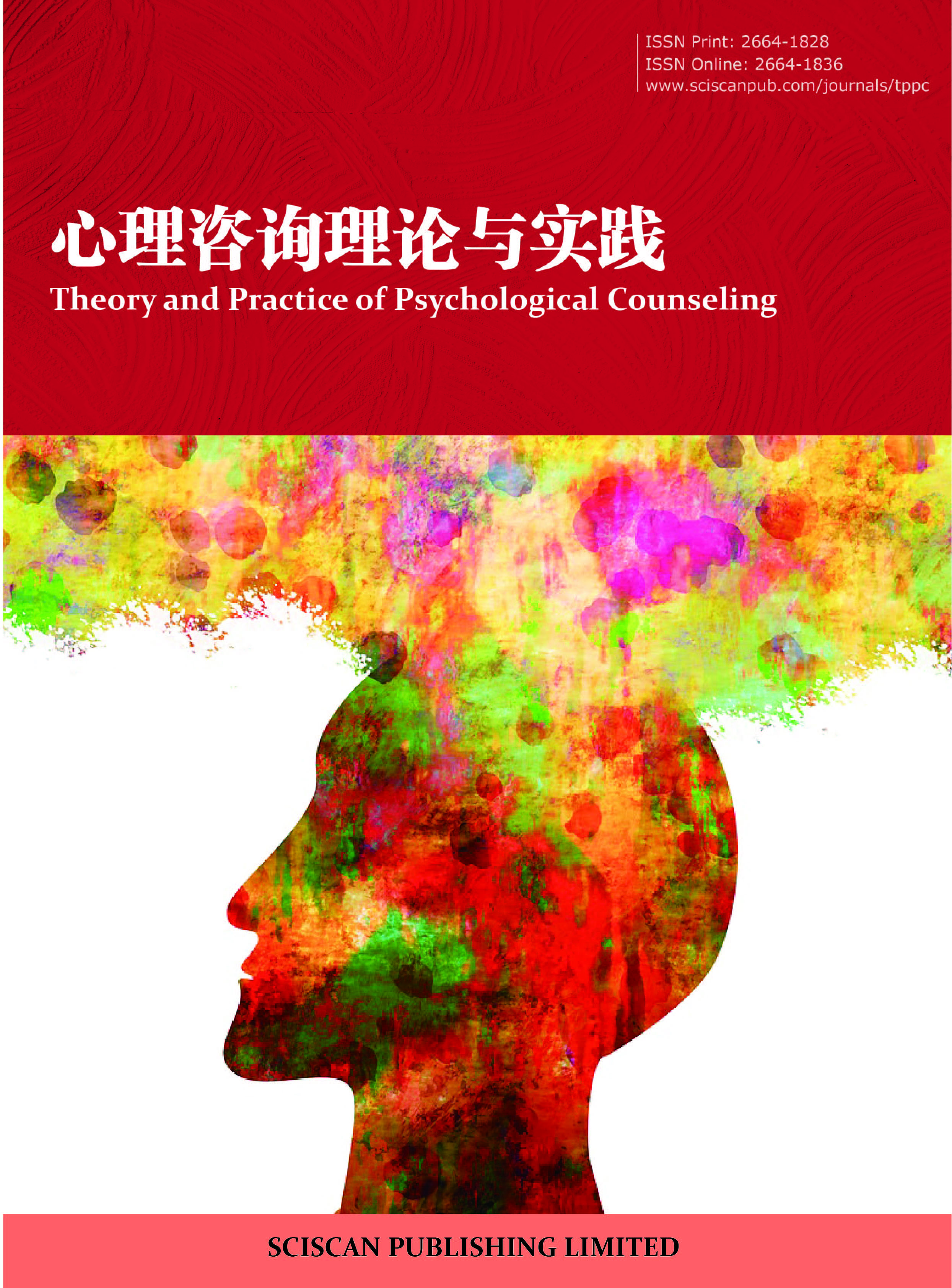Theory and Practice of Psychological Counseling
不同情绪情感和经验回避类别对大学生非自杀性自伤的影响:基于潜在剖面分析
The Impact of Different Emotional States and Experiential Avoidance Categories on Non-suicidal Self-injury among College Students: A Latent Profile Analysis
- Authors: 汪靖雯¹ 张斌² 崔文龙² 毛竹君² 钟欣桐² 许娅² 刘欣怡²
-
Information:
1. 伍家岗外国语小学,宜昌; 2. 三峡大学,宜昌
-
Keywords:
Latent Profile Analysis (LPA); Depression; Anxiety; Loneliness; Perceived emotional dysregulation潜在剖面分析; 抑郁; 焦虑; 孤独; 感知情绪失效
- Abstract: Objective: To reveal the triggering mechanisms of non-suicidal self-injury (NSSI) behavior among college students based on different latent categories of emotional states and experiential avoidance. Methods: This study measured 3,812 college students and employed latent profile analysis to identify latent categories of emotional risk factors, exploring how these factors, in combination with experiential avoidance, impact NSSI. Results: (1) Three latent profiles of emotional risk factors were identified: “Low-Risk Emotional Group” (65%), “High-Risk Emotional Inhibition Group” (30%), and “High-Risk Emotional Group” (5%). (2) Three combination patterns of emotional risk factors and experiential avoidance were identified: “Low-Risk and Low-Avoidance Group” (64%), “Medium-Risk and Medium-Avoidance Group” (31%), and “High-Risk and High-Avoidance Group” (5%). (3) Multiple linear regression analysis revealed that higher levels of emotional risk factors and experiential avoidance corresponded to an increased risk of NSSI. Conclusion: This study clarified the impact of different combinations of risk factors on NSSI, providing empirical support for future intervention research. 目的:揭示不同情绪情感和经验回避的潜在类别对大学生非自杀性自伤行为的促发机制。方法:对3812名大学生进行测量,运用潜在剖面分析方法识别情绪情感风险因素的潜在类别,并探索这些因素与经验回避的组合模式对非自杀性自伤行为的影响。结果:(1)情绪情感风险因素存在三个潜在剖面:“低危情绪风险组”(65%)、“高危情绪失效组”(30%)、“高危情绪风险组”(5%);(2)情绪情感风险因素与经验回避的组合模式可分为三类:“低风险-低回避组”(64%)、“中风险-中回避组”(31%)、“高风险-高回避组”(5%);(3)经多元线性回归分析发现,情绪情感风险和经验回避水平越高,非自杀性自伤的风险相应越大。结论:本研究明确了不同风险因素组合对非自杀性自伤行为的影响,为后续干预研究提供了实证支持。
- DOI: https://doi.org/10.35534/tppc.0611091
- Cite: 汪靖雯,张斌,崔文龙,等.不同情绪情感和经验回避类别对大学生非自杀性自伤的影响:基于潜在剖面分析[J].心理咨询理论与实践,2024,6(11):755-763.
大学生多处于青春后期,是非自杀性自伤(NSSI)的高发人群,近年来呈上升趋势[1]。青少年NSSI是自杀行为的强预测因子[2]。研究表明,NSSI与成长经历、亲子关系、童年创伤、家庭状况、人际关系及人格特征等因素密切相关。根据NSSI行为的远端路径模型,儿童期创伤和不良家庭环境等易感因素会导致个体产生较高的负性情绪和认知,容忍力降低,进而诱发人际易感因素(如较差的沟通能力、较弱的社会解决能力),最终导致经验回避和NSSI行为[3]。自伤者相较于普通人往往具有更多的消极情绪体验,如抑郁、焦虑和孤独感[4]。在近端或远端危险因素的影响与作用下,个体能够感知到更多的负性情绪,进而产生逃离消极情绪的愿望。若个体的情绪调节能力不足,便可能采取非自杀性自伤的方式,借由身体疼痛来消除负性情绪的影响,从而缓解心理痛苦。这种行为模式体现为对消极情绪的经验回避,且已有研究表明经验回避是负性生活事件与NSSI之间的中介变量[5]。由于自伤后负性情绪能够暂时得以缓解,情绪恢复平静,这进一步强化了NSSI行为。此外,已有研究发现,大学生群体中NSSI的发生率相对较高,并常伴有抑郁等问题[6]。大学生的抑郁情绪、焦虑情绪与非自杀性自伤之间存在正相关关系[7],孤独感在消极情绪与NSSI之间起到中介作用[8]。大学生面临着学业、就业、经济、人际、家庭和自我等多方面的压力,如果无法有效处理负性情绪,就有可能通过经验回避的方式进行自伤。
由于情绪情感因素具有状态性,越来越多的研究从个体中心视角出发,借助模型拟合手段来对个体进行分类,并解释不同剖面间的差异。此类研究多集中在情绪情感风险因素的潜在剖面及其与经验回避的联合潜在剖面上。虽然已有研究通过潜在剖面分析探讨了手机成瘾类型对大学生情绪的影响[9],但针对不同情绪情感风险和经验回避联合剖面的大学生是否存在NSSI行为差异,还需进一步研究。
本研究旨在通过潜在剖面分析,深入考察不同情绪情感和经验回避类别对大学生非自杀性自伤行为的影响。采用个体中心的研究方法,探索不同群体在剖面上呈现出的性别、年级差异及其与NSSI行为之间的关系。具体而言,本研究分析了大学生情绪情感风险因素及其与个体风险因素的联合潜在剖面,揭示了这些潜在类别对NSSI行为的即时性和继时性影响。
1 对象与方法
1.1 对象
本研究选取了湖北省某省属高校四个年级的大学生作为被试群体,共收集有效问卷3812份。其中,大一学生102人,占比2.68%;大二学生2246人,占比58.92%;大三学生974人,占比25.55%;大四学生490人,占比12.85%。在最终纳入分析的被试中,男生1645名(43.15%),女生2167名(56.85%)。
1.2 研究工具
1.2.1 抑郁情绪问卷
本研究采用国内学者胡星辰(2014)编制的“抑郁情绪问卷”。该问卷共有9个题目,例题如“觉得自己很糟,或觉得自己很失败,或让自己或家人失望”,采用4点计分方式(1=没有,4=几乎每天)。经检验,本研究中该问卷的Cronbach系数为:α=0.931。
1.2.2 广泛性焦虑量表
本研究采用国内学者何筱衍(2010)编制的“广泛性焦虑量表”。该问卷共有7个题目,例题如“感觉紧张、焦虑或不安”,采用4点计分方式(1=没有,4=几乎每天)。经检验,本研究中该量表的Cronbach系数为:α=0.952。
1.2.3 孤独感问卷
本研究采用国内学者朱迪(2018)编制的“孤独感问卷”。该问卷共有3个题目,例题如“感到被别人孤立”,采用5点计分方式(1=几乎没有,5=总是)。经检验,本研究中该问卷的Cronbach系数为:α=0.898。
1.2.4 自杀信念与企图问卷
本研究采用Martin(1995)编制的“自杀信念与企图问卷”。该问卷共有2个题目,例题如“我有过试图结束自己生命的行为”,采用5点计分方式(1=几乎没有,5=总是)。经检验,本研究中该问卷的Cronbach系数为:α=0.922。
1.2.5 感知情绪失效问卷
本研究采用Zielinski(2018)编制的“感知情绪失效问卷”。该问卷共有10个题目,例题如“当我分享自己的情绪或感受时,别人没有把我当回事”,采用5点计分方式(1=从不,5=总是)。经检验,本研究中该问卷的Cronbach系数为:α=0.924。
1.2.6 经验性回避问卷
本研究采用曹慧(2021)编制的“经验性回避问卷”。该问卷共有15个题目,例题如“当我回忆起不愉快的经历,我会尝试把它们从脑海中抹去”,采用6点计分方式(1=完全不同意,6=完全同意)。经检验,本研究中该问卷的Cronbach系数为:α=0.921。
1.2.7 非自杀性自伤问卷
本研究采用Leung(2012)编制的“非自杀性自伤问卷”。该问卷共有7个题目,例题如“故意严重抓伤自己以致出血或留疤痕”,采用4点计分方式(1=从不,4=六次或更多)。经检验,本研究中该问卷的Cronbach系数为:α=0.956。
1.3 统计分析
本研究借助“抑郁情绪问卷”“广泛性焦虑量表”“孤独感问卷”“自杀信念与企图问卷”“感知情绪失效问卷”“经验性回避问卷”和“非自杀性自伤问卷”对大学生群体展开问卷调查。在施测前,研究者向被试宣读了指导语,然后在整个学校范围内发放电子版问卷,并对存在漏项和重复选项的问卷进行剔除。所收集的数据通过SPSS 25.0进行量化处理和分析,并使用Mplus 8.3进行潜在剖面分析。
2 结果
2.1 共同方法偏差检验
为检验是否存在同源方差,本研究使用Harman单因素检验对所有问卷项目进行主成分分析。结果显示,共提取出6个特征根大于1的因子,其中最大因子方差解释率为35.07%(小于40%)。因此,本研究未发现明显的共同方法偏差情况。
2.2 情绪情感风险因素层面的潜在剖面分析
首先,以情绪情感因素为观察变量,从1分类开始依次进行潜在剖面分析,分别对抑郁、焦虑、孤独、自杀信念与企图、感知情绪失效建立无条件潜在剖面分析模型(LPA),并抽取1~6个潜在类别用以识别抑郁、焦虑、孤独、自杀信念与企图、感知情绪失效剖面的最佳数目。
情绪情感层面的拟合指标详见表1。AIC、BIC和aBIC值随着模型类别数的增加逐渐减少,且所有模型的熵值(entropy)均超过0.8,表明各模型具有较高的分类精度。BLRT检验结果表明,增加类别数能够持续优化模型拟合,LMR-LRT检验结果显示,只有3分类和5分类模型满足统计显著性要求(p<0.05),而5分类模型(LMR-LRT检验)中每个亚群组占样本总体的比例低于5%,故3分类模型优于5分类、4分类以及6分类模型,并结合情绪情感层面的实际意义,最终确定3分类模型为情绪情感层面剖面的最优模型。
其中,如图1所示,类别1处于低抑郁、低焦虑、低孤独、低自杀信念与企图、低感知情绪失效风险状态,命名为“低危情绪风险组”(65%);类别2的抑郁、焦虑、孤独、自杀信念与企图风险相对较低,但感知情绪失效风险偏高,命名为“高危情绪失效组”(30%);类别3处于高抑郁、高焦虑、高孤独、高自杀信念与企图、高感知情绪失效风险状态,命名为“高危情绪风险组”(5%)。
表1 情绪情感层面潜在剖面分析模型拟合指标
Table 1 Model fit indicators for potential profile analysis of emotional sentiment levels
|
类别 |
AIC |
BIC |
aBIC |
Entropy |
P-LMR |
P-BLRT |
类别概率 |
|
1 |
36851.38 |
36913.84 |
36882.06 |
||||
|
2 |
29276.30 |
29376.24 |
29325.40 |
0.995 |
0.0000 |
<0.001 |
3606(0.95)/206(0.05) |
|
3 |
23640.75 |
23778.16 |
23708.26 |
0.937 |
0.0000 |
<0.001 |
2466(0.65)/1155(0.30)/191(0.05) |
|
4 |
21403.02 |
21577.90 |
21488.93 |
0.94 |
0.1302 |
<0.001 |
2449(0.64)/246(0.07)/959(0.25)/ 158(0.04) |
|
5 |
17895.87 |
18108.23 |
18000.19 |
0.956 |
0.0012 |
<0.001 |
2433(0.64)/889(0.23)/312(0.08)/ 127(0.03)/51(0.01) |
|
6 |
17830.82 |
18080.65 |
17953.55 |
0.957 |
0.4208 |
<0.001 |
19(0)/127(0.03)/879(0.23)/ 2424(0.64)/312(0.08)/51(0.01) |
注:粗体表示最佳拟合模型。

图1 情绪情感层面潜在剖面图
Figure 1 Potential profiles at the emotional affective level
对情绪情感风险因素和个体风险因素(经验回避)进行联合潜在剖面分析,结果如表2所示。随着类别数的增加,AIC、BIC和aBIC值逐步降低,而Entropy值始终保持在0.8以上。综合考虑模型的简洁性与拟合优度,确定3分类模型为最佳拟合模型。其中,如图2所示,类别1处于低水平的情绪情感层面和低水平经验回避状态,命名为“低风险-低回避组”(64%);类别2处于中水平的情绪情感层面和中水平经验回避状态,命名为“中风险-中回避组”(31%);类别3处于高水平的情绪情感层面和高水平经验回避状态,命名为“高风险-高回避组”(5%)。
表2 情绪情感风险因素和经验回避联合潜在剖面分析模型拟合指标
Table 2 Model fit indicators for the joint potential profile analysis model of emotional sentiment risk factors and empirical avoidance
|
类别 |
AIC |
BIC |
aBIC |
Entropy |
P-LMR |
P-BLRT |
类别概率 |
|
1 |
47191.82 |
47266.77 |
47228.64 |
||||
|
2 |
39510.27 |
39628.95 |
39568.57 |
0.995 |
0.0000 |
<0.001 |
3604(0.95)/208(0.05) |
|
3 |
33731.482 |
33893.875 |
33811.26 |
0.937 |
0.0000 |
<0.001 |
2440(0.64)/1182(0.31)/190(0.05) |
|
4 |
31490.162 |
31696.277 |
31591.42 |
0.940 |
0.1346 |
<0.001 |
2429(0.64)/978(0.26)/246(0.06)/ 159(0.04) |
|
5 |
29982.682 |
30232.518 |
30105.417 |
0.955 |
0.7142 |
<0.001 |
2322(0.61)/95(0.02)/222(0.06)/ 151(0.04)/1022(0.27) |
|
6 |
28853.138 |
29146.695 |
28997.351 |
0.941 |
0.8109 |
1.000 |
358(0.09)/2015(0.53)/88(0.02)/ 264(0.07)/108(0.03)/979(0.26) |
注:粗体表示最佳拟合模型。

图2 情绪情感风险因素和经验回避的联合剖面图
Figure 2 Joint profiles of emotional affective risk factors and experiential avoidance
2.3 性别和年级在联合剖面上的差异分析
性别差异分析结果显示:在低风险-低回避、中风险-中回避、高风险-高回避这三个群体中,男性分别占比42%、42%、64%,女性占比58%、58%、36%。由此可见,女性在情绪情感风险和经验回避联合剖面上的整体风险程度高于男性。年级差异分析结果显示:低风险-低回避组中,大一学生占比3%,大二学生占比60%,大三学生占比25%,大四学生占比12%;中风险-中回避组中,大一学生占比3%,大二学生占比57%,大三学生占比25%,大四学生占比15%;高风险-高回避组中,大一学生占比1%,大二学生占比56%,大三学生占比28%,大四学生占比15%。综合看来,大二学生在情绪情感风险和经验回避剖面上的风险程度最高。
2.4 情绪情感风险因素和经验回避联合剖面的协方差分析
在对比情绪情感因素和个体风险因素(经验回避)的联合模型中,发现不同类别大学生的非自杀性自伤情况不同。在将性别和年龄作为控制变量的情况下,ANCOVA分析结果表明,不同类别的非自杀性自伤总分存在显著差异[F(3,3808)=321.14,p<0.001,η2=0.14]。事后检验结果进一步显示,高风险-高回避组(5%)、中风险-中回避组(31%)、低风险-低回避组(64%)的非自杀性自伤总分依次递减(p<0.001),且各组之间差异显著。
2.5 情绪情感风险因素和经验回避的联合类别在非自杀性自伤上多元线性回归分析
鉴于因变量为连续变量,而自变量为分类变量,故设置哑变量(虚拟变量)进行多元线性回归分析。其分析结果如表3所示,相较于低风险-低回避组,中风险-中回避组(B=0.04,p<0.001)的非自杀性自伤发生率增高,其非自杀性自伤程度比低风险-低回避组高出0.04。同样,相较于低风险-低回避组,高风险-高回避组(B=0.47,p<0.001)的非自杀性自伤发生率亦有所增高,其非自杀性自伤程度比低风险-低回避组高出0.47。
表3 情绪情感风险因素和经验回避的联合类别在非自杀性自伤得分上差异检验
Table 3 Tests of differences in non-suicidal self-injury scores for the joint categories of emotional-emotional risk factors and experiential avoidance
|
模型 |
未标准化系数 B |
标准误差 |
标准化系数 Beta |
t |
显著性 |
|
(常量) |
1.013 |
0.005 |
206.282 |
*** |
|
|
中风险-中回避组 |
0.042 |
0.009 |
0.075 |
4.927 |
*** |
|
高风险-高回避组 |
0.467 |
0.018 |
0.388 |
25.585 |
*** |
|
低风险-低回避组 |
0 |
||||
|
因变量:非自杀性自伤 |
|||||
注:*p<0.05,**p<0.01,***p<0.001。
3 讨论
大学生心理危机的促发机制呈现出复杂多样的特点。本研究运用潜在剖面分析方法,不仅从抑郁、焦虑、孤独、自杀信念与企图、感知情绪失效、经验回避的联合模式角度出发,探讨它们与非自杀性自伤之间的关系,还试图探索大学生在情绪情感风险因素层面上的分组特征。研究结果显示,大学生的情绪情感风险因素可以分为三种模式:低危情绪风险组(65%)、高危情绪失效组(30%)、高危情绪风险组(5%)。大部分大学生(65%)归属于“低危情绪风险组”,即他们的抑郁、焦虑、孤独、自杀意念、情绪失效水平较低,整体心理健康状况较好。然而,约有30%的大学生属于“高危情绪失效组”,这一群体可能由于学业压力、人际关系挑战及自我期望过高等原因,导致其情绪感知能力出现减弱的情况。余下5%的大学生则属于“高危情绪风险组”,表明他们在抑郁、焦虑、孤独、自杀意念与情绪失效等方面均得分较高,且更可能将自伤作为缓解痛苦的一种方式。已有研究表明,非自杀性自伤行为在大学生群体中的发生率相对较高,且往往伴随着抑郁等心理问题的出现。因此,大学生心理健康工作应重点关注“高危情绪风险组”群体的预防和干预措施。
当个体不愿意接纳不愉快的情绪体验时,往往会试图改变或以其他方式控制不想要的心理体验,这很可能是经验回避的结果。已有研究表明,当将焦虑情绪视为不好的倾向时,便预示着可能会产生逃避行为,进而会努力抑制焦虑感的产生[10]。在本研究样本所涉及的情绪情感风险因素和经验回避的联合模式中,存在低风险-低回避组(64%)、中风险-中回避组(31%)和高风险-高回避组(5%)。这表明约有31%的大学生暴露于较高水平的情绪情感风险因素和个体风险因素当中,并且较高的情绪情感风险通常会伴随着较高的经验回避风险。而另有5%的大学生则暴露于高风险的情绪情感因素和个体经验回避风险因素当中。依据关系参照理论(relation frame theory),人们在处于中、高危情绪情感风险因素的影响下,往往会产生回避的想法,以帮助个体摆脱当下所处的语言和认知关系网络。每当个体遭受到由抑郁、焦虑、孤独等情绪情感体验和受挫关系网络所带来的负性体验时,为了减轻这种痛苦情绪,个体会采用各种方式来回避,而经验性回避则是一种常见方式[11]。有研究发现,高水平经验性回避与大学生的自杀意念有关,中、高水平的经验性回避是大学生自杀意念的危险因素[12]。
女性在低风险-低回避群体、中风险-中回避组群体、高风险-高回避组群体中所面临的风险因素均高于男性。这一现象可能是由于社会文化、生理、心理、认知、社会支持以及心理疾病风险等多种因素的综合影响所致。在心理因素层面,女性往往更倾向于表达情感、关注他人的情感状态,这可能使她们更容易受到情绪波动的影响。此外,女性在面对挑战时可能更加倾向于内化情绪,而不是外化表现出来,这可能会进一步增加她们的情绪风险。在认知方面,女性更加倾向于负性思维、自我批评等,这可能会增加她们对情绪风险因素的敏感性。年级在情绪情感风险和经验回避联合剖面上的差异结果表明,大二学生在该联合剖面上所呈现出的风险因素高于其他年级。这一状况可能是由于学业压力增加、社交压力增加、职业发展压力、自我认知和成长以及生活方式改变等多种因素共同作用所引发的。在学业方面,大二通常是学生接触到更多专业课程和学科知识的阶段,也是开始进行专业方向选择的时候。学业压力的增加可能导致学生情绪情感的波动,尤其是在面对挑战时,学生可能产生焦虑和不安,进而促使大二学生采取经验回避的方式,最终增加了非自杀性自伤风险。在社交方面,大二学生可能在适应大学生活和新社交圈子的过程中面临更多的挑战,诸如与同龄人建立新的友谊、处理人际关系问题等,均有可能增加情绪情感风险和采取经验回避行为的可能性。在自我认知和成长方面,大二学生通常处于青春期末期或早期成年期,正处于身心发育和自我认知的关键阶段。在这个阶段,他们可能面临着自我身份认同、角色转变、个人价值观的重新审视等问题,这些情况都可能引发情绪情感波动和经验回避行为。在生活方式改变方面,大二学生可能面临从家庭环境到大学校园的过渡,生活方式、作息时间等方面的改变可能影响到他们的情绪状态。同时,他们开始独立生活,需要面对更多的生活责任和挑战,这也可能会增加情绪情感风险和出现经验回避行为的可能性。
此外,从情绪情感风险与经验回避的联合模式来看,高风险-高回避组(5%)、中风险-中回避组(31%)、低风险-低回避组(64%)的大学生在非自杀性自伤发生率依次减少,且两两之间存在着显著性差异。这表明大学生所感知到的情绪情感风险因素和经验回避风险因素的水平越高时,其发生非自杀自伤行为的概率也越高。情绪情感风险因素和经验回避风险因素对大学生的心理危机存在着累积效应,不同风险因素的叠加可能会引发个体更高的心理痛苦水平,从而增加非自杀性自伤的风险。值得注意的是,高风险-高回避组的非自杀自伤发生率显著高于中风险-中回避组(差值=0.425),提示情绪情感风险因素是非自杀自伤的近端关键因素,而经验回避在非自杀自伤中可能也发挥着作用。可能的解释是:经验回避可能作为一种应对策略,帮助个体缓解情绪不适。当面对负性情绪或压力时,部分大学生可能会选择通过经验回避的方式来减轻不适情绪,这种逃避行为可能包括避免思考、回避社交场合、逃避面对问题等方面。然而,长期且过度的经验回避可能会导致情绪情感的积累和失调,最终可能引发非自杀性自伤行为。此外,经验回避可能会导致一系列心理健康问题,例如社交退缩、自我孤立、情绪抑制等。这些心理副作用可能会增加个体产生非自杀自伤行为的风险。例如,经验回避可能导致个体在情感上感到孤独、绝望和无助,从而进一步增加自我伤害的可能性;经验回避也可能导致个体情绪失调,包括抑郁、焦虑等情绪问题,而这些情绪问题可能会增加个体发生非自杀自伤行为的风险。
综上所述,本研究揭示了抑郁、焦虑、孤独、自杀信念与企图,以及感知情绪失效的联合模式对大学生非自杀性自伤行为所产生的累积影响,为情绪情感风险因素在大学生心理危机中所发挥的作用提供了初步的证据支持。同时,本研究还发现,在情绪情感风险因素与经验回避风险因素的联合模式中,存在非自杀性自伤行为的聚集效应。这充分表明在大学生心理危机的促发机制中,情绪情感风险因素与个体心理因素之间存在复杂的交互作用。因此,在大学生心理危机干预中,应高度重视不同情绪情感风险类别与个体经验回避水平的综合处理。
参考文献
[1]褚成静,潘艳云,董树平.大学生自伤行为与家庭环境及应付方式的关系研究[J].中国健康心理学杂志,2012,20(5):4.
[2]刘婉,万宇辉,陶芳标,等.青少年非自杀性自伤行为评估方法研究进展[J].中国公共卫生,2016,32(4):478—4.
[3]周兴蓉.童年创伤经历对青少年非自杀性自伤行为的影响机制[D].贵阳:贵州师范大学硕士学位论文,2023.
[4]Baetens I,Andrews T,Claes L,et al.The association between family functioning and NSSI in adolescence:The mediating role of depressive symptoms[J].Family Science,2015,6(1):330-337.
[5]曹馨元.青少年负性生活事件与自伤行为的关系研究[D].长春:长春师范大学硕士学位论文,2022.
[6]顾怀婷,刘根义,李晶.大学生非自杀性自伤行为与抑郁、述情障碍的相关性[J].中国健康心理学杂志,2018(1):6-9.
[7]李陆.蒙古族高校学生非自杀性自伤行为与抑郁焦虑的关联[J].中国学校卫生,2022(1):96-99.
[8]谢沂霖.童年心理虐待与忽视对青少年非自杀性自伤行为的影响:孤独感的中介作用及其干预研究[D].武汉:华中师范大学硕士学位论文,2023.
[9]曾奕欣,龙专,张斌,等.不同手机成瘾类型对大学生情绪的影响:基于潜在剖面分析[J].中国健康心理学杂志,2023,31(9):1370-1375.
[10]范瑞娟.正念认知疗法对广泛性焦虑障碍患者的正念注意觉知、经验性回避、认知融合的干预研究[D].安徽:安徽医科大学硕士学位论文,2023.
[11]薛亦菲,侯牧天,徐霞霞,等.校园欺凌与青少年自杀意念的关系:经验性回避和睡眠质量的链式中介[J].心理学通讯,2022(4):249-255.
[12]于瑶琨,姚志英,王涛,等.大学生经验性回避与自杀意念的关系[J].中国心理卫生杂志,2023(11):976-981.
















